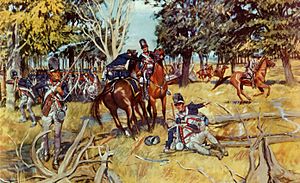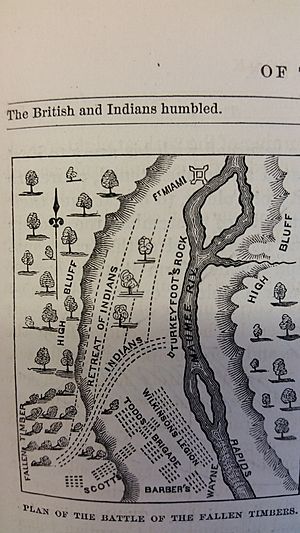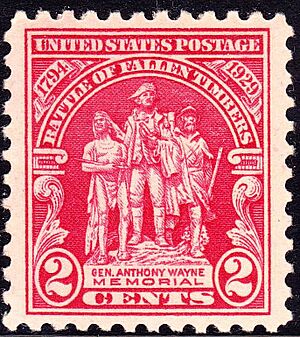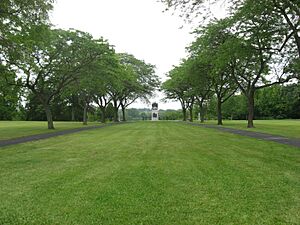Battle of Fallen Timbers facts for kids
Quick facts for kids Battle of Fallen Timbers |
|||||||
|---|---|---|---|---|---|---|---|
| Part of the Northwest Indian War | |||||||
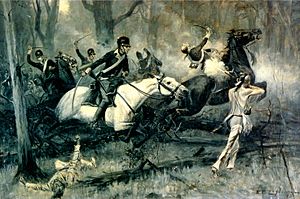 Battle of Fallen Timbers, Unknown artist |
|||||||
|
|||||||
| Belligerents | |||||||
| Western Confederacy |
|||||||
| Commanders and leaders | |||||||
| Blue Jacket Egushawa Little Turtle Buckongahelas |
|||||||
| Strength | |||||||
| 3,000 | 1,300 | ||||||
| Casualties and losses | |||||||
| 33 killed 100 wounded |
25–40 killed | ||||||
The Battle of Fallen Timbers happened on August 20, 1794. It was the last big fight of the Northwest Indian War. This war was between Native American tribes, known as the Western Confederacy, and their British friends, against the new United States. They were fighting for control of the Northwest Territory.
The battle took place near the Maumee River in what is now northwestern Ohio. The area was full of trees that had been knocked down by a tornado. This made the battlefield very messy.
Major General "Mad Anthony" Wayne led the U.S. army, called the Legion of the United States. General Charles Scott and his Kentucky Militia also helped. They fought against a group of Native American forces. These included the Shawnee led by Blue Jacket and Ottawas led by Egushawa.
The battle was very quick, lasting only about an hour. The U.S. forces won, and the Native American fighters scattered. This victory ended the main fighting in the area. After the battle, the Treaty of Greenville and Jay's Treaty were signed. These treaties made Native Americans leave most of modern-day Ohio. This opened the land for White American settlers. It also made the British leave their forts in the southern Great Lakes region of the United States.
Contents
Why the Battle Happened
After the American Revolutionary War ended in 1783, Great Britain gave the land northwest of the Ohio River to the United States. This land was south of the Great Lakes. But the Native American nations living there were not part of that agreement. They were upset when settlers from the United States started moving onto their lands.
The U.S. government tried to organize the region and made treaties for settlement. But the Western Confederacy of Native American nations did not agree to these treaties. They refused to accept them. Fighting broke out between Native Americans and U.S. settlers in Ohio and Kentucky.
Early U.S. Campaigns Fail
During George Washington's first time as President, the U.S. tried to stop the Native American confederacy twice.
- In 1790, the Harmar campaign failed. The confederacy won a big victory, and the U.S. army had to retreat.
- In 1791, Governor Arthur St. Clair led another campaign. His army was badly beaten by the combined Native American forces.
After these defeats, the U.S. tried to make peace. President Washington also asked Major General "Mad" Anthony Wayne to build a stronger army. If peace talks failed, Wayne was to make sure the U.S. controlled the western lands.
Wayne's Army Prepares
Wayne gathered about 2,000 soldiers. He also had Choctaw and Chickasaw men as scouts. In the spring of 1793, Wayne moved his army to Fort Washington. He set up a camp there.
Wayne soon learned that the Native American leaders had not agreed to a peace deal. So, he moved his army north into Native American territory. In November, his army built a new fort called Fort Greeneville. They stayed there for the winter.
Wayne sent about 300 men to build Fort Recovery where St. Clair's army had been defeated in 1791. They also found cannons lost there. In response, the British built Fort Miami to stop Wayne's advance. In June, Fort Recovery was attacked, but the U.S. army held the fort. This battle showed that the Native American confederacy was not fully united.
Leaders Disagree
Before leaving Fort Recovery, Wayne sent a final peace offer to the confederacy leaders. Little Turtle thought Wayne was too strong and suggested they should negotiate. But Blue Jacket disagreed. He said Little Turtle was a traitor and believed Wayne would be defeated, just like the earlier U.S. generals. Little Turtle then let Blue Jacket lead. The British were worried about these disagreements and sent more soldiers to Fort Miami.
Wayne left Fort Recovery on August 17. He marched north with about 1,000 Kentucky militia soldiers. Native American scouts noticed that Wayne's army always built a strong camp each afternoon. This made it harder to attack them by surprise. Wayne's army built Fort Adams and Fort Defiance. As they got close to Fort Miami, Wayne built Fort Deposit to store supplies. This allowed his soldiers to fight more easily.
The Battle of Fallen Timbers
On August 18, Native American forces captured a U.S. scout. They learned that Wayne planned to attack on August 19 or 20. Knowing this, Alexander McKee told the confederacy to pick a good place to fight.
Blue Jacket chose a spot near present-day Toledo, Ohio. There was a large area of trees that had been blown down by a storm. This tangled mess of trees, called "fallen timbers," stretched for almost a mile. It created a natural barrier that would protect the Native American fighters.
About 1,500 Native American warriors gathered. They included Shawnees, Delawares, Miamis, Wyandots, Ojibwas, Odawas, Potawatomis, Mingos, and some Mohawks. A small group of Canadian soldiers, dressed like Native Americans, also joined them. The Native American forces fasted for several days before the battle.
The Fight Begins
On the morning of August 20, Wayne's army advanced. Many Native American warriors had left their positions to eat, thinking there would be no battle because of the morning rain.
The U.S. army marched in tight groups. Their lead scouts entered the fallen timbers area. Suddenly, the Odawas and Potawatomis fired, scattering the Kentucky militia at the front. Some U.S. soldiers ran back, causing confusion.
General Wayne quickly moved his light infantry soldiers forward. They stopped the Native American advance while the main U.S. lines formed. Artillery was brought up and fired grapeshot at the Native American lines. Blue Jacket's plan was now in trouble.
Wayne told his soldiers to "Charge the damned rascals with the bayonet!" Captain Robert Campbell led his dragoons (soldiers on horseback) forward. They charged with their swords drawn. Many were shot, and Captain Campbell was killed.
Native American Retreat
Meanwhile, other U.S. forces fought the Wyandots, Lenape, and Canadians. A heavy exchange of gunfire happened. A group of Kentucky militia moved quickly through a swamp and attacked the Canadians from the side. The Native American forces had to retreat from their positions. They found it hard to regroup in the rough terrain.
The Native American forces tried to gather again in a ravine on their way to Fort Miami. But many leaders were wounded or killed. Egushawa was shot in the eye. Little Otter was badly hurt. Another chief, Turkey Foot, was shot and died instantly. According to Alexander McKee, losing so many leaders made the Native American losses seem worse than they were. Many warriors fled to Fort Miami.
The land beyond the ravine was more open. This allowed the U.S. army to move faster. The retreat became a disorganized run. Only the Canadians and Wyandots protected the rear.
Fort Miami's Closed Gates
The entire battle lasted only about 70 minutes. The Native American warriors ran toward Fort Miami, expecting safety. But they were surprised to find the gates closed. Major William Campbell, the British commander of the fort, refused to open the gates. He did not want to start a war with the United States.
The remaining Native American army continued north. They met their families near Swan Creek. McKee tried to get them to fight again, but they refused. They felt betrayed by the British at Fort Miami.
The U.S. army lost 33 men and had about 100 wounded. They reported finding 30-40 dead Native American warriors. The British reported that the Native American confederacy lost 19 warriors killed, including Chief Turkey Foot. Six white men fighting with the Native Americans were also killed. Chiefs Egushawa and Little Otter were wounded.
After the Battle
Wayne's army camped near Fort Miami for three days. Major Campbell, the British commander, asked why they were there. Wayne replied that the sound of their guns and the Native American retreat had already answered. Wayne knew he couldn't take Fort Miami by force. He didn't have enough supplies for a long siege.
Instead, to show that the U.S. controlled the area, Wayne rode alone to the fort's walls. He slowly looked at the outside of the fort. The British soldiers inside thought about firing at him, but they didn't. They were already fighting France and didn't want to start another war with the U.S. Wayne's army destroyed Native American villages and crops nearby. They also burned Alexander McKee's trading post in sight of Fort Miami. Even with these actions, the British did not open the fort gates. Wayne also didn't want to start a war with Great Britain. So, on August 26, his army left for Fort Recovery.
Wayne expected another attack, but the Native Americans did not form a large army again. Small groups continued to bother Wayne's army and supply lines. Wayne sent peace invitations, but they were not answered. On September 15, Wayne led his army to the Miami capital of Kekionga. There, they built Fort Wayne. Wayne left in late October. That winter, he also strengthened his line of forts with Fort St. Marys, Fort Loramie, and Fort Piqua.
What Happened Next
Even though the U.S. army had some losses, the battle was quick. A Native American warrior later said that Little Turtle had warned them they would lose if they didn't make peace. The rainy start to the day was a sign they would be defeated.
Peace talks began in December. By January, many Native American groups wanted to make peace. In the summer of 1795, the confederacy met with General Wayne. They negotiated the Treaty of Greenville, which was signed on August 3. This treaty opened most of modern-day Ohio for settlement. It also helped define the relationships between the U.S., Britain, and Spain after the colonial period.
General Wayne died two years later from an illness. He was returning from inspecting Detroit.
For many years after the battle, Odawas visited the battle site. They left memorials at Turkey Foot Rock, where Chief Turkey Foot died.
The Northwest region stayed mostly peaceful until the War of 1812. Wayne's helper, William Henry Harrison, later became governor of the Indiana Territory. He continued the policy of buying land from Native American nations. Tecumseh, a young Shawnee who fought at Fallen Timbers, refused to sign the Greenville Treaty. He later created a new group of tribes to resist the U.S. Harrison attacked this new group in the 1811 Battle of Tippecanoe.
Many soldiers from the Battle of Fallen Timbers became famous later. These include William Clark, who explored with Lewis, and William Henry Harrison, who became the 9th President of the United States.
Legacy of the Battle
On September 14, 1929, the United States Post Office Department released a stamp to remember the 135th anniversary of the Battle of Fallen Timbers. This stamp showed the Battle of Fallen Timbers Monument.
Fallen Timbers Battlefield Park
For 200 years, people thought the battle happened on the flat land near the Maumee River. But Dr. G. Michael Pratt, an expert from Heidelberg University (Ohio), believed it was a quarter-mile higher up. He looked at old papers that mentioned a ravine.
In 1995 and 2001, Dr. Pratt used metal detectors to search the area. He found musket balls, parts of guns, uniform buttons, and a bayonet. This proved that the main fighting happened at this higher spot.
Because of Dr. Pratt's work, the land became a National Historic Site in 1999. A grant allowed the Metroparks of the Toledo Area to buy the land in 2001. Now, it is a park connected with the National Park Service.
Fallen Timbers State Monument
The Ohio Historical Society keeps a small park at the place people first thought the battle happened. This park has the Battle of Fallen Timbers Monument. It honors both Major General Anthony Wayne and his army, and Little Turtle and his warriors. There are also plaques that describe the battle and honor the Native American tribes who fought. The main monument has tributes on each of its four sides. The park is near Maumee in Lucas County. Turkey Foot Rock, which marks where Chief Turkey Foot died, is also at this site.
Images for kids
See also
 In Spanish: Batalla de los Árboles Caídos para niños
In Spanish: Batalla de los Árboles Caídos para niños


